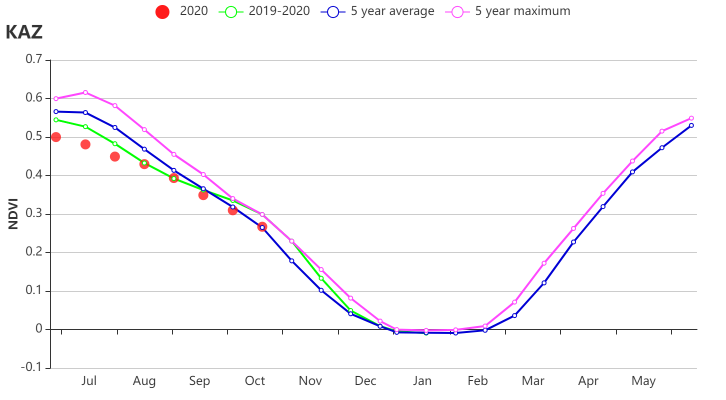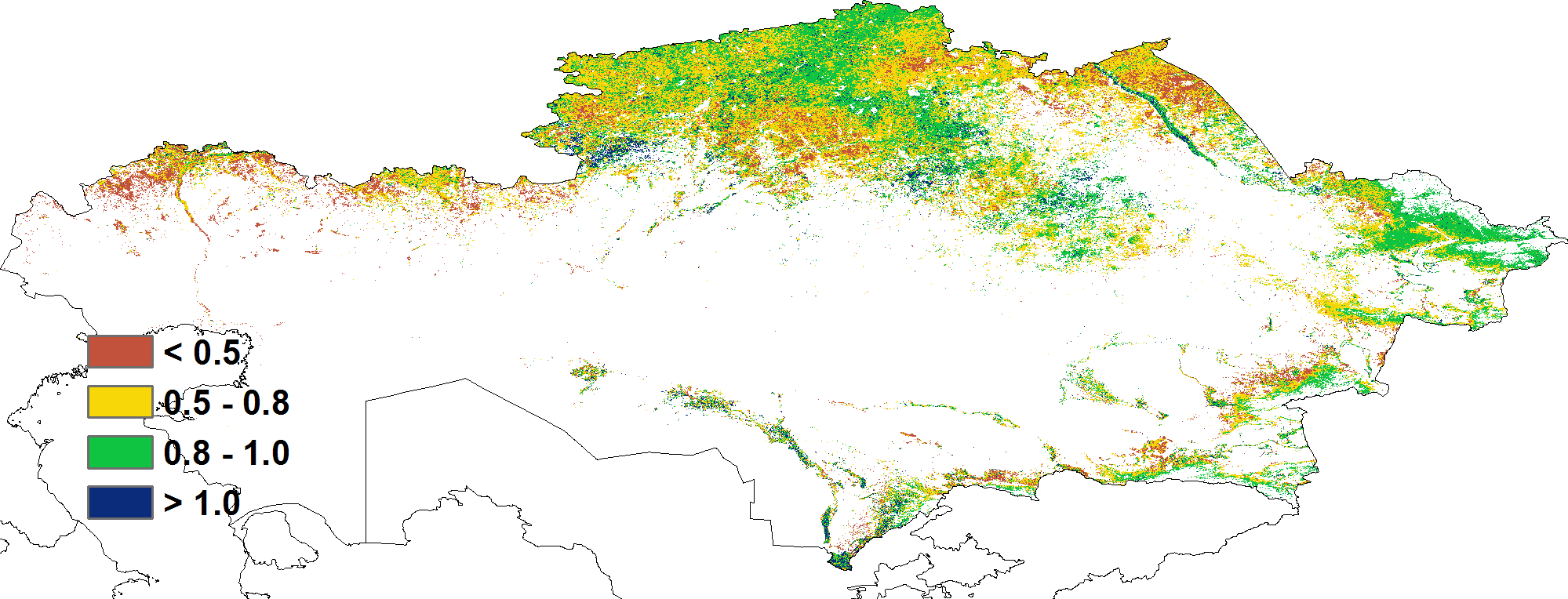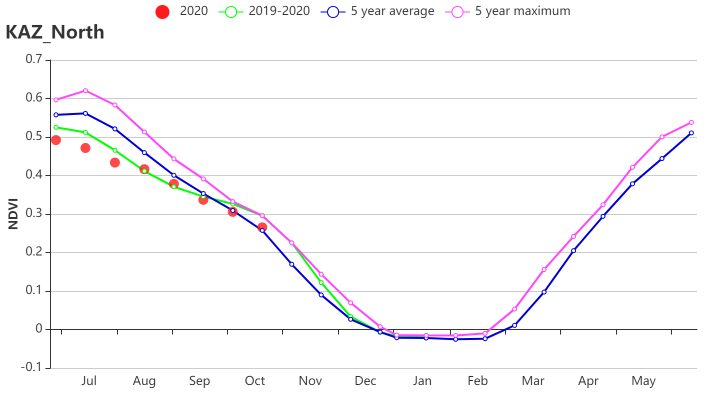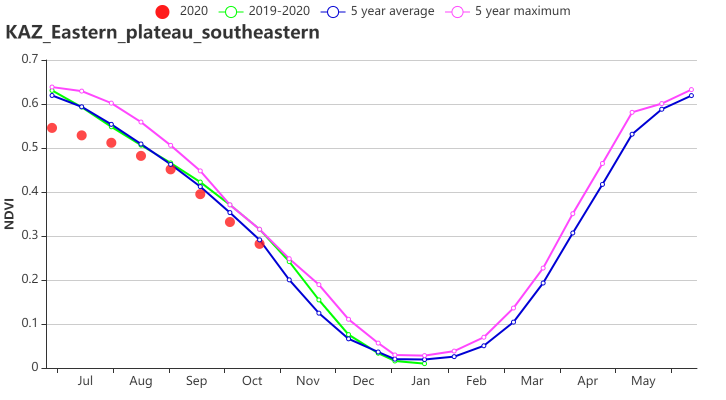当前报告期涵盖了哈萨克斯坦春小麦的生长和收获期,南部地区的少量燕麦和冬小麦于10月开始播种。7月至10月作物长势总体低于或接近于平均水平。
与过去15年平均水平相比,累积降水量偏高23%,而平均气温和光合有效辐射分别偏低0.7°C和4%。全国平均降水在七月下旬和八月中旬距平偏高幅度超过10mm;平均气温整个监测期在平均值上下波动变化。农业气象条件作用使得潜在生物量处于平均水平。
全国最佳植被状态指数(VCIx)平均为0.72, 耕地种植比例(CALF)较近5年平均水平下降7%,复种指数下降18%。VCIx空间分布与NDVI距平聚类分布图结果的一致性很高。大约21.5%的耕作区作物长势高于平均水平,主要分布在阿克莫拉州东南部和东哈萨克斯坦州东北部。大约66.9%的耕作区,包括南部区域,以及北哈萨克斯坦州、巴甫洛达尔州和北哈萨克斯坦州大部分地区,整个监测期除7月中旬外作物长势都低于平均水平。剩余的11.6%的耕作区自7月至8月中旬作物长势低于平均水平,随后直至10月底恢复到平均水平以上,这些区域主要分布在科斯塔奈州北部地区。
总的来讲,受耕地利用程度与作物长势均较往年差的影响,春小麦产量预计低于平均水平。
区域分析
基于耕作制度、气候分区以及地形条件,哈萨克斯坦可细分为三个子区域,其中有三个分区是农作物的主要种植区,分别是北部地区(112)、东部高原与东南部地区(111)和南部地区(110)。
在北部地区,与过去15年同期平均水平相比,降水量偏高20%,平均气温和光合有效辐射均低于平均水平。NDVI过程线结果显示7月至9月该区域作物长势低于平均水平。VCIx为0.71,且CALF较平均水平偏低8%。该区域作物产量预计低于平均水平。
在东部高原和东南地区,作物长势在7月至8月低于平均水平,9月至10月接近于平均水平。降水量较平均水平偏高31%,光合有效辐射和平均气温分别偏低6%和1.5°C。VCIx为0.76,且CALF较平均水平偏低6%。该区域春小麦产量预计低于平均水平。
南部地区降水仅40mm,较平均水平显著偏低24%。VCIx为0.77。NDVI过程线结果显示7月至10月作物长势总体偏差。
图3.5 2020年7月-10月哈萨克斯坦作物长势

(a) 主要作物物候历

(b) 基于 NDVI 的作物生长过程线

(c) 最佳植被状况指数

(d)降水时间过程线

(e)温度时间过程线

![]()
(f)NDVI 距平空间聚类图 (g) NDVI 距平聚类过程线

(h) 基于NDVI的作物生长过程线(哈萨克斯坦北部)

(i) 基于NDVI的作物生长过程线(哈萨克斯坦南部)

(i) 基于NDVI的作物生长过程线(哈萨克斯坦东部高原和东南部地区)
表3.1哈萨克斯坦农业生态分区2020年7月-10月与过去 15 年(15YA)同期农业气象指标
| 分区 | 累积降水 | 平均气温 | 光合有效辐射 | 潜在生物量 | ||||
| 当前季 (mm) | 15YA 距平 (%) | 当前季 (°C) | 15YA 距平 (°C) | 当前季 (MJ/m2) | 15YA 距平 (%) | 当前季 (gDM/m2) | 15YA 距平 (%) | |
| 北部地区 | 197 | 20 | 14.3 | -0.3 | 900 | -3 | 419 | 0 |
| 东部高原和东南部地区 | 284 | 31 | 13.5 | -1.5 | 1453 | -1 | 425 | -1 |
| 南部地区 | 40 | -24 | 20.6 | -1.1 | 1203 | -4 | 523 | 15 |
表3.2 哈萨克斯坦农业生态分区 2020年7月-10月与近5年(5YA)同期农情指标
| 分区 | 耕地种植比例 | 最佳植被状况指数 | 复种指数 | ||
| 当前季 | 5YA 距平 (%) | 当前季 | 当前季 | 5YA 距平 (%) | |
| 北部地区 | 77 | -8 | 0.71 | 100 | 0 |
| 东部高原和东南部地区 | 78 | -6 | 0.76 | 100 | -1 |
| 南部地区 | 58 | 4 | 0.77 | 100 | 0 |
